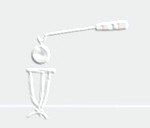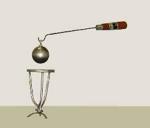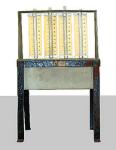

 Menu
Menu
|
School Spano |

|
||
|
Function Measure of the minimum temperature during a certain period. | |||
|
|||
|
Description It is a thermometer placed horizontally on a wooden table. The liquid leaves the position of a pole unchanged inside of a capillary when it expands, while it drags the pole when it contracts. | |||
 Menu
Menu
|
Function It is used to study the variation of the length of a metallic bar in function of the variation of temperature. |
 | ||
|
|||
|
Description Two small columns set in a cast iron base with double square capitals, with a bar on top of these. One of the end of the top bar is held by a regulating pressure screw. At the free end, the bar pushes on versus the arm of a lever at right angles, the other arm of which bears a mobile in front of a separated scale. The cotton sock that protrudes from a horizontal lamp is later soaked with alcohol. Two little bars of brass and iron of equal dimensions are added to the apparatus. | |||
 Menu
Menu
|
Function It is used to study the contraction of a bar of metal during the cooling. |

| ||
|
|||
|
Description We heat the iron square bar without the top screw nut over a coal cooker or a gas-cooker, without making it red-hot. We insert the bar into the proper cavities of the base, that have two pads of cement asbestos at the bottom, so as to prevent a fast transmission of the heat. In the hole of the bar we introduce one end of a cast iron rod and in the meantime, we strongly screw the handle. The apparatus is left for a while, then the cast iron rod breaks up and the bar is launched away. | |||
|
Function Studying the expansion of solids. |

| ||
|
|||
|
Description The ring is sustained by a tripod to prevent the sphere from dropping out of the apparatus when it crosses the ring. The brass sphere is hollow and without welding and it warms in little time. It is not necessary to reach a high temperature, as the difference between the sphere and the ring is very small. The hook with the wooden handle is used to hold the sphere on the flame and to carry it onto the ring. | |||
|
Function The pendulum is prepare in order to make the variation of length due to the variation of temperature as small as possible. |

| ||
|
|||
|
Description Model with four bars, two brass ones and two iron ones, with a brass lens suspended by its centre. It has a support with an iron cast foot and a very small iron column. | |||
|
Function Studying the expansion of different liquids. |

| ||
|
|||
|
Description Function: Description: A metallic frame holds four little balls of glass with the same diameter that are linked to the same number of capillary tubes with the same section. After introducing some mercury up to a certain level (low) into one of the bulbs, we fill the other bulbs with different previously coloured liquids (e.g. water, alcohol, petrol and essence of turpentine) up to the same level. A millimetric scale on a running lame of aluminium is applied on each capillary. It is easy to understand its purpose and utility. A small prismatic zinc tank that will be filled with water and in which the bulbs will be immerged is given together with the frame. | |||
|
Function Studying the anomalous behaviour of water. |

| ||
|
|||
|
Description Upon and under the sleeve, through two holes in the test tube, we introduce two thermometers. After filling the test tube with water, the two thermometers will show the same temperature. When we put a mixture of ice and salt, as the water gets cooler, it falls to the bottom and at once the temperature of the lower thermometer falls down, while the upper thermometer stays almost stationary. From then on the temperature of the upper thermometer will go down, reaching almost grade 0, while the lower thermometer stays on grade 4, because the water at grade 4 has reached its maximum specific weight and so cannot be substituted by colder water. | |||